Environmental Safety and Self-Perceived Quality of Life and Health: The Example of the European Union
Abstract
1. Introduction
- To construct a synthetic indicator of environmental safety (ES_Score) for EU27 countries using the TOPSIS method;
- To perform a comparative assessment and classification of EU27 countries through ranking and clustering;
- To compare the positioning of EU countries in terms of environmental safety with selected indicators of quality of life and health by analysing the distribution of these variables across quartile intervals;
- To assess the influence of environmental safety on subjective perceptions of quality of life and health.
- (1)
- What are the spatial and temporal patterns in the variation of environmental safety across European Union countries?
- (2)
- How do residents of countries with varying levels of environmental safety perceive their quality of life and health?
- (3)
- Which environmental safety factors are most strongly associated with subjectively perceived quality of life and health?
2. Literature Review
2.1. Environmental Safety
2.2. The Concept of Quality of Life and Its Environmental Conditions
3. Materials and Methods
4. Results
4.1. Descriptive Statistics of Environmental and Quality of Life and Health Variables
4.2. A Comparison of Environmental Safety Among EU(27) Countries Using the TOPSIS-Based Synthetic Index (ES_Score)
4.3. Which Countries Are Similar in Terms of Environmental Safety?
4.4. Self-Perceived Quality of Life and Health in EU(27) Countries—A Comparative Analysis
4.5. Self-Perceived Quality of Life and Health in Groups of Countries with Similar Environmental Safety Levels
4.6. Univariate Analysis of the Relationship Between Environmental Safety and Self-Perceived Quality of Life and Health
4.7. Multivariate Analysis of the Relationship Between Environmental Safety and Self-Perceived Quality of Life and Health
5. Discussion
6. Conclusions
Author Contributions
Funding
Institutional Review Board Statement
Informed Consent Statement
Data Availability Statement
Conflicts of Interest
References
- Belau, M.H.; Jung, L.; Maurer, T.; Obi, N.; Behrens, S.; Seibold, P.; Becher, H.; Chang-Claude, J. Social Relationships and Their Impact on Health-Related Quality of Life in a Long-Term Breast Cancer Survivor Cohort. Cancer 2024, 130, 3210–3218. [Google Scholar] [CrossRef] [PubMed]
- Faka, A. Assessing Quality of Life Inequalities. A Geographical Approach. ISPRS Int. J. Geo-Inf. 2020, 9, 600. [Google Scholar] [CrossRef]
- Felce, D.; Perry, J. Quality of Life: Its Definition and Measurement. Res. Dev. Disabil. 1995, 16, 51–74. [Google Scholar] [CrossRef]
- Fernandez-Portero, C.; Amian, J.G.; Alarcón, D.; Arenilla Villalba, M.J.; Sánchez-Medina, J.A. The Effect of Social Relationships on the Well-Being and Happiness of Older Adults Living Alone or with Relatives. Healthcare 2023, 11, 222. [Google Scholar] [CrossRef]
- Gaweł-Luty, E. Wybrane Konteksty Jakości Życia. Colloquium 2022, 14, 163–173. [Google Scholar]
- Chang, K.K.P.; Wong, F.K.Y.; Chan, K.L.; Wong, F.; Ho, H.C.; Wong, M.S.; Ho, Y.S.; Yuen, J.W.M.; Siu, J.Y.; Yang, L. The Impact of the Environment on the Quality of Life and the Mediating Effects of Sleep and Stress. Int. J. Environ. Res. Public. Health 2020, 17, 8529. [Google Scholar] [CrossRef]
- Pacione, M. Urban Environmental Quality and Human Wellbeing—A Social Geographical Perspective. Landsc. Urban Plan. 2003, 65, 19–30. [Google Scholar] [CrossRef]
- Riedlova, P.; Tomaskova, H.; Slachtova, H.; Babjakova, J.; Jirik, V. The Impact of Environmental Conditions on Lifestyle Quality in Industrial and Non-Industrial Region in the Czech Republic. Front. Public Health 2025, 13, 1505170. [Google Scholar] [CrossRef]
- EEA. Chapter 5: Environment, Health and Quality of Life. In The European Environment; Publications Office of the European Union: Luxembourg, 2010. [Google Scholar] [CrossRef]
- Levett, R. Sustainability Indicators—Integrating Quality of Life and Environmental Protection. J. R. Stat. Soc. Ser. A Stat. Soc. 1998, 161, 291–302. [Google Scholar] [CrossRef]
- Lochan Behera, K.; Taneja, M.; Faiz, A.; Hanumanthayya, M.; Sharma, V.K.; Kore, N.; Antony, M. Environmental Health Interventions and Their Impact on Quality of Life. Health Leadersh. Qual. Life 2024, 3, 383. [Google Scholar]
- Brusseau, M.L.; Ramirez-Andreotta, M.; Pepper, I.L.; Maximillian, J. Chapter 26—Environmental Impacts on Human Health and Well-Being. In Environmental and Pollution Science, 3rd ed.; Brusseau, M.L., Pepper, I.L., Gerba, C.P., Eds.; Academic Press: Cambridge, MA, USA, 2019; pp. 477–499. ISBN 978-0-12-814719-1. [Google Scholar]
- EEA. Environmental Health Impacts. Available online: https://www.eea.europa.eu/en/topics/in-depth/environmental-health-impacts (accessed on 4 July 2025).
- Ferreira, S.; Akay, A.; Brereton, F.; Cuñado, J.; Martinsson, P.; Moro, M.; Ningal, T.F. Life Satisfaction and Air Quality in Europe. Ecol. Econ. 2013, 88, 1–10. [Google Scholar] [CrossRef]
- Panagopoulos, T.; González Duque, J.A.; Bostenaru Dan, M. Urban Planning with Respect to Environmental Quality and Human Well-Being. Environ. Pollut. 2016, 208, 137–144. [Google Scholar] [CrossRef]
- Zhang, L.; Yang, Y.; Lin, Y.; Chen, H. Human Health, Environmental Quality and Governance Quality: Novel Findings and Implications from Human Health Perspective. Front. Public Health 2022, 10, 890741. [Google Scholar] [CrossRef] [PubMed]
- Chukkali, S.; Rastogi, K.; Agrawal, A.; Nayar, S.; Raj, P. Air Quality Index, Personality Traits and Their Impact on the Residential Satisfaction and Quality of Life: An Exploratory Path Analysis Model. Asian J. Water Environ. Pollut. 2024, 21, 39–46. [Google Scholar] [CrossRef]
- Du, Y.; You, S.; Zhang, M.; Song, Z.; Liu, W.; Li, D. Analysis of Correlation between Quality of Life and Subjective Evaluation of Air Quality—Empirical Research Based on CHARLS 2018 Data. Atmosphere 2021, 12, 1551. [Google Scholar] [CrossRef]
- Krekel, C.; Kolbe, J.; Wüstemann, H. The Greener, the Happier? The Effect of Urban Land Use on Residential Well-Being. Ecol. Econ. 2016, 121, 117–127. [Google Scholar] [CrossRef]
- McEachan, R.R.C.; Yang, T.C.; Roberts, H.; Pickett, K.E.; Arseneau-Powell, D.; Gidlow, C.J.; Wright, J.; Nieuwenhuijsen, M. Availability, Use of, and Satisfaction with Green Space, and Children’s Mental Wellbeing at Age 4 Years in a Multicultural, Deprived, Urban Area: Results from the Born in Bradford Cohort Study. Lancet Planet. Health 2018, 2, e244–e254. [Google Scholar] [CrossRef]
- Mukherjee, D.; Safraj, S.; Tayyab, M.; Shivashankar, R.; Patel, S.A.; Narayanan, G.; Ajay, V.S.; Ali, M.K.; Narayan, K.V.; Tandon, N.; et al. Park Availability and Major Depression in Individuals with Chronic Conditions: Is There an Association in Urban India? Health Place 2017, 47, 54–62. [Google Scholar] [CrossRef]
- Qiao, Y.; Chen, Z.; Chen, Y.; Zheng, T. Deciphering the Link Between Mental Health and Green Space in Shenzhen, China: The Mediating Impact of Residents’ Satisfaction. Front. Public Health 2021, 9, 561809. [Google Scholar] [CrossRef]
- Stigsdotter, U.K.; Ekholm, O.; Schipperijn, J.; Toftager, M.; Kamper-Jørgensen, F.; Randrup, T.B. Health Promoting Outdoor Environments—Associations between Green Space, and Health, Health-Related Quality of Life and Stress Based on a Danish National Representative Survey. Scand. J. Public Health 2010, 38, 411–417. [Google Scholar] [CrossRef]
- Braubach, M.; Tobollik, M.; Mudu, P.; Hiscock, R.; Chapizanis, D.; Sarigiannis, D.A.; Keuken, M.; Perez, L.; Martuzzi, M. Development of a Quantitative Methodology to Assess the Impacts of Urban Transport Interventions and Related Noise on Well-Being. Int. J. Environ. Res. Public Health 2015, 12, 5792–5814. [Google Scholar] [CrossRef]
- Byaello, K. Impact of Noise Pollution on Community Health and Well-Being in Lagos, Nigeria. J. Wet. Health 2023, 4, 15–21. [Google Scholar] [CrossRef]
- Eurostat Database—Eurostat. Available online: https://ec.europa.eu/eurostat/web/main/data/database (accessed on 10 June 2025).
- Eurostat Income and Living Conditions (Ilc). Available online: https://ec.europa.eu/eurostat/cache/metadata/en/ilc_sieusilc.htm (accessed on 13 May 2025).
- Eurostat. Quality of Life Indicators—Measuring Quality of Life. Available online: https://ec.europa.eu/eurostat/statistics-explained/index.php?title=Quality_of_life_indicators_-_measuring_quality_of_life (accessed on 7 March 2025).
- World Bank Group. World Bank Open Data. Available online: https://data.worldbank.org (accessed on 10 June 2025).
- Hirsch Ballin, E.; Dijstelbloem, H.; de Goede, P. The Extension of the Concept of Security. In Security in an Interconnected World: A Strategic Vision for Defence Policy; Springer: Cham, Switzerland, 2020; pp. 13–39. [Google Scholar]
- Adebayo, G.O. Counter-Radicalization Policies and Policing in Education: Making a Case for Human Security in Europe. Heliyon 2021, 7, e05721. [Google Scholar] [CrossRef]
- Grey, D.; Garrick, D.; Blackmore, D.; Kelman, J.; Muller, M.; Sadoff, C. Water Security in One Blue Planet: Twenty-First Century Policy Challenges for Science. Philos. Trans. R. Soc. Math. Phys. Eng. Sci. 2013, 371, 20120406. [Google Scholar] [CrossRef] [PubMed]
- Mordwa, S. Subiektywne Poczucie Zagrożenia a Zachowania Obronne Mieszkańców Łodzi. Acta Univ. Lodz. Folia Geogr. Socio-Oeconomica 2016, 23, 151–170. [Google Scholar] [CrossRef]
- Wyligała, H. Bezpieczeństwo Ekologiczne; Wydawnictwo Naukowe Uniwersytetu Ignatianum w Krakowie: Kraków, Poland, 2023. [Google Scholar]
- Szewczyk, Z. Ecology Safety—Sustainable Development and Economical Aspect. Ann. Pol. Assoc. Agric. Agribus. Econ. 2017, XIX, 295–300. [Google Scholar] [CrossRef]
- Zapolska, K. Bezpieczeństwo Ekologiczne Jako Element Bezpieczeństwa Narodowego RP. In Współczesne Oblicza Bezpieczeństwa; Guzik-Makaruk, E.M., Pływaczewski, E.W., Eds.; Temida2: Białystok, Poland, 2015; pp. 209–217. ISBN 978-83-62813-66-7. [Google Scholar]
- Butts, K.H. Environmental Security and Climate Change: A Link to Homeland Security. J. Homel. Secur. Emerg. Manag. 2014, 11, 269–279. [Google Scholar] [CrossRef]
- Lonergan, S. Human Security, Environmental Security and Sustainable Development. In Environment and Security; Palgrave Macmillan UK: London, UK, 2000; pp. 66–83. [Google Scholar]
- Polyakova, E.; Gorina, L. Environmental Security and Sustainable Development of Large Urban Centres. E3S Web Conf. 2021, 250, 01003. [Google Scholar] [CrossRef]
- Ashraf, M.A.; Amescua García, C.M.; Chowdhury, A.J.K. Introduction Environment, Development and Sustainability. Rev. Int. Contam. Ambient. 2019, 35, 7–9. [Google Scholar] [CrossRef]
- Li, G. Sustainable Development Strategies in Urban Planning. Adv. Econ. Manag. Polit. Sci. 2024, 96, 107–111. [Google Scholar] [CrossRef]
- Ciszek, M. Ecological (Environmental) Security and Ecological (Environmental) Security Culture. Kult. Bezpieczeństwa 2016, 5, 11–22. [Google Scholar]
- Leszczyński, M. Bezpieczeństwo Ekologiczne w Poszerzonej Domenie Bezpieczeństwa. Nierówności Społeczne Wzrost Gospod. 2023, 74, 21–32. [Google Scholar] [CrossRef]
- Chaudhry, K.T.; Javed, A.; Nazir, M.A. Humanitarian Crisis and Intervention: Securitizing Environmental Challenges in Pakistan. Ann. Hum. Soc. Sci. 2022, 3, 10–20. [Google Scholar] [CrossRef]
- Iqbal, K.M.J.; Akhtar, N.; Amir, S.; Khan, M.I.; Shah, A.A.; Tariq, M.A.U.R.; Ullah, W. Multi-Variable Governance Index Modeling of Government’s Policies, Legal and Institutional Strategies, and Management for Climate Compatible and Sustainable Agriculture Development. Sustainability 2022, 14, 11763. [Google Scholar] [CrossRef]
- Bezpalova, O.I.; Onopriienko, S.; Tarasov, S.; Zavalna, Z.; Starynskyi, M. State Environmental Security in National and Globalization Aspects. J. Secur. Sustain. Issues 2020, 9, 797–806. [Google Scholar] [CrossRef] [PubMed]
- Raczkowski, K.; Żukrowska, K.; Żuber, M. Interdyscyplinarność Nauk o Bezpieczeństwie. Paradygmat, Wiedza, Demarkacja; Difin: Warszawa, Poland, 2013; ISBN 978-83-7641-880-3. [Google Scholar]
- Szwed, K. Konstytucyjny Obowiązek Prowadzenia Polityki Zapewniającej Bezpieczeństwo Ekologiczne Współczesnemu i Przyszłym Pokoleniom. Przegląd Prawa Konst. 2022, 67, 65–77. [Google Scholar] [CrossRef]
- Allenby, B.R. Environmental Security: Concept and Implementation. Int. Polit. Sci. Rev. 2000, 21, 5–21. [Google Scholar] [CrossRef]
- Toktogulov, A. Environmental safety and sustainable development. EurasianUnionScientists 2021, 1, 9–11. [Google Scholar] [CrossRef]
- Calaminus, G.; Barr, R. Economic Evaluation and Health-Related Quality of Life. Pediatr. Blood Cancer 2008, 50, 1112–1115. [Google Scholar] [CrossRef]
- McKevitt, C.; Wolfe, C. Quality of Life: What, How, Why?: The View of Healthcare Professionals. Qual. Ageing Older Adults 2002, 3, 13–19. [Google Scholar] [CrossRef]
- Waterman, A.S. The Relevance of Aristotle’s Conception of Eudaimonia for the Psychological Study of Happiness. Theor. Philos. Psychol. 1990, 10, 39–44. [Google Scholar] [CrossRef]
- Bradley, C. Feedback on the FDA’s February 2006 Draft Guidance on Patient Reported Outcome (PRO) Measures from a Developer of PRO Measures. Health Qual. Life Outcomes 2006, 4, 78. [Google Scholar] [CrossRef] [PubMed]
- Bergland, A.; Narum, I. Quality of Life Demands Comprehension and Further Exploration. J. Aging Health 2007, 19, 39–61. [Google Scholar] [CrossRef] [PubMed]
- Helseth, S.; Misvær, N. Adolescents’ Perceptions of Quality of Life: What It Is and What Matters. J. Clin. Nurs. 2010, 19, 1454–1461. [Google Scholar] [CrossRef]
- Streimikiene, D. Natural and Built Environments and Quality of Life in EU Member States. J. Int. Stud. 2014, 7, 9–19. [Google Scholar] [CrossRef]
- Çelik, F.; Jaiyeoba, E.B. The Contributions of the Green Areas in Residence Immediate Environment on Quality of Urban Life. Sage Open 2023, 13, 1–17. [Google Scholar] [CrossRef]
- Wang, K.; Tseng, S.; Lee, C.; Wang, K. Transfer Behaviors in Stroke and Dementia Development Associated with Environmental Risks. Geriatr. Gerontol. Int. 2024, 24, 766–772. [Google Scholar] [CrossRef]
- EC. A Sustainable Europe by 2030—European Commission. Available online: https://commission.europa.eu/publications/sustainable-europe-2030_en (accessed on 7 March 2025).
- EU. Treaty on European Union. Available online: https://ec.europa.eu/eurostat/statistics-explained/index.php?title=Glossary:Treaty_on_European_Union (accessed on 7 March 2025).
- OECD. OECD Guidelines on Measuring Subjective Well-Being. Available online: https://www.oecd.org/en/publications/oecd-guidelines-on-measuring-subjective-well-being_9789264191655-en.html (accessed on 7 March 2025).
- Chakraborty, S. TOPSIS and Modified TOPSIS: A Comparative Analysis. Decis. Anal. J. 2022, 2, 100021. [Google Scholar] [CrossRef]
- Vavrek, R. Evaluation of the Impact of Selected Weighting Methods on the Results of the TOPSIS Technique. Int. J. Inf. Technol. Decis. Mak. 2019, 18, 1821–1843. [Google Scholar] [CrossRef]
- Bánhidi, Z.; Dobos, I. Sensitivity of TOPSIS Ranks to Data Normalization and Objective Weights on the Example of Digital Development. Cent. Eur. J. Oper. Res. 2024, 32, 29–44. [Google Scholar] [CrossRef]
- Breusch, T.S.; Pagan, A.R. A Simple Test for Heteroscedasticity and Random Coefficient Variation. Econometrica 1979, 47, 1287. [Google Scholar] [CrossRef]
- Hausman, J.A. Specification Tests in Econometrics. Econometrica 1978, 46, 1251. [Google Scholar] [CrossRef]
- Cliff, A.D.; Ord, J.K. Spatial Processes: Models & Applications; Pion: London, UK, 1981; ISBN 978-0-85086-081-8. [Google Scholar]
- Anselin, L. Local Indicators of Spatial Association—LISA. Geogr. Anal. 1995, 27, 93–115. [Google Scholar] [CrossRef]
- Gallego-Alvarez, I.; Vicente-Galindo, M.P.; Galindo-Villardón, M.P.; Rodríguez-Rosa, M. Environmental Performance in Countries Worldwide: Determinant Factors and Multivariate Analysis. Sustainability 2014, 6, 7807–7832. [Google Scholar] [CrossRef]
- Štreimikienė, D.; Samusevych, Y.; Bilan, Y.; Vysochyna, A.; Sergi, B.S. Multiplexing Efficiency of Environmental Taxes in Ensuring Environmental, Energy, and Economic Security. Environ. Sci. Pollut. Res. 2022, 29, 7917–7935. [Google Scholar] [CrossRef]
- Reverte, C. The Importance of Institutional Differences among Countries in SDGs Achievement: A Cross-Country Empirical Study. Sustain. Dev. 2022, 30, 1882–1899. [Google Scholar] [CrossRef]
- Rothe, D. Seeing like a Satellite: Remote Sensing and the Ontological Politics of Environmental Security. Secur. Dialogue 2017, 48, 334–353. [Google Scholar] [CrossRef]
- Özcan, B.A. Defining Environmental Security as a National Security Issue. Int. J. Polit. Secur. 2023, 5, 73–94. [Google Scholar] [CrossRef]
- Räisänen, H.; Hakala, E.; Eronen, J.T.; Hukkinen, J.I.; Virtanen, M.J. Comprehensive Security: The Opportunities and Challenges of Incorporating Environmental Threats in Security Policy. Polit. Gov. 2021, 9, 91–101. [Google Scholar] [CrossRef]
- Kantemnidis, D.; Botetzagias, I. Understanding the Environmental Security Perceptions of the European Union’s Security Actors. Sustainability 2023, 15, 13027. [Google Scholar] [CrossRef]
- EPI. 2024 Environmental Performance Index. Available online: https://epi.yale.edu/measure/2024/EPI (accessed on 11 July 2025).
- Okpara, U.T.; Stringer, L.C.; Dougill, A.J.; Bila, M.D. Conflicts about Water in Lake Chad: Are Environmental, Vulnerability and Security Issues Linked? Prog. Dev. Stud. 2015, 15, 308–325. [Google Scholar] [CrossRef]
- Makeda, K. The Psychological Effects of Environmental Degradation on Human Well-Being. Int. J. Humanit. Soc. Sci. 2024, 2, 26–37. [Google Scholar] [CrossRef]
- Adger, W.N.; de Campos, R.S.; Siddiqui, T.; Gavonel, M.F.; Szaboova, L.; Rocky, M.H.; Bhuiyan, M.R.A.; Billah, T. Human Security of Urban Migrant Populations Affected by Length of Residence and Environmental Hazards. J. Peace Res. 2021, 58, 50–66. [Google Scholar] [CrossRef]
- Lim, J.Y.; Moon, K.-K. Perceived Environmental Threats and Pro-Environmental Behaviors: Investigating the Role of Political Participation Using a South Korean Survey. Int. J. Environ. Res. Public. Health 2020, 17, 3244. [Google Scholar] [CrossRef]
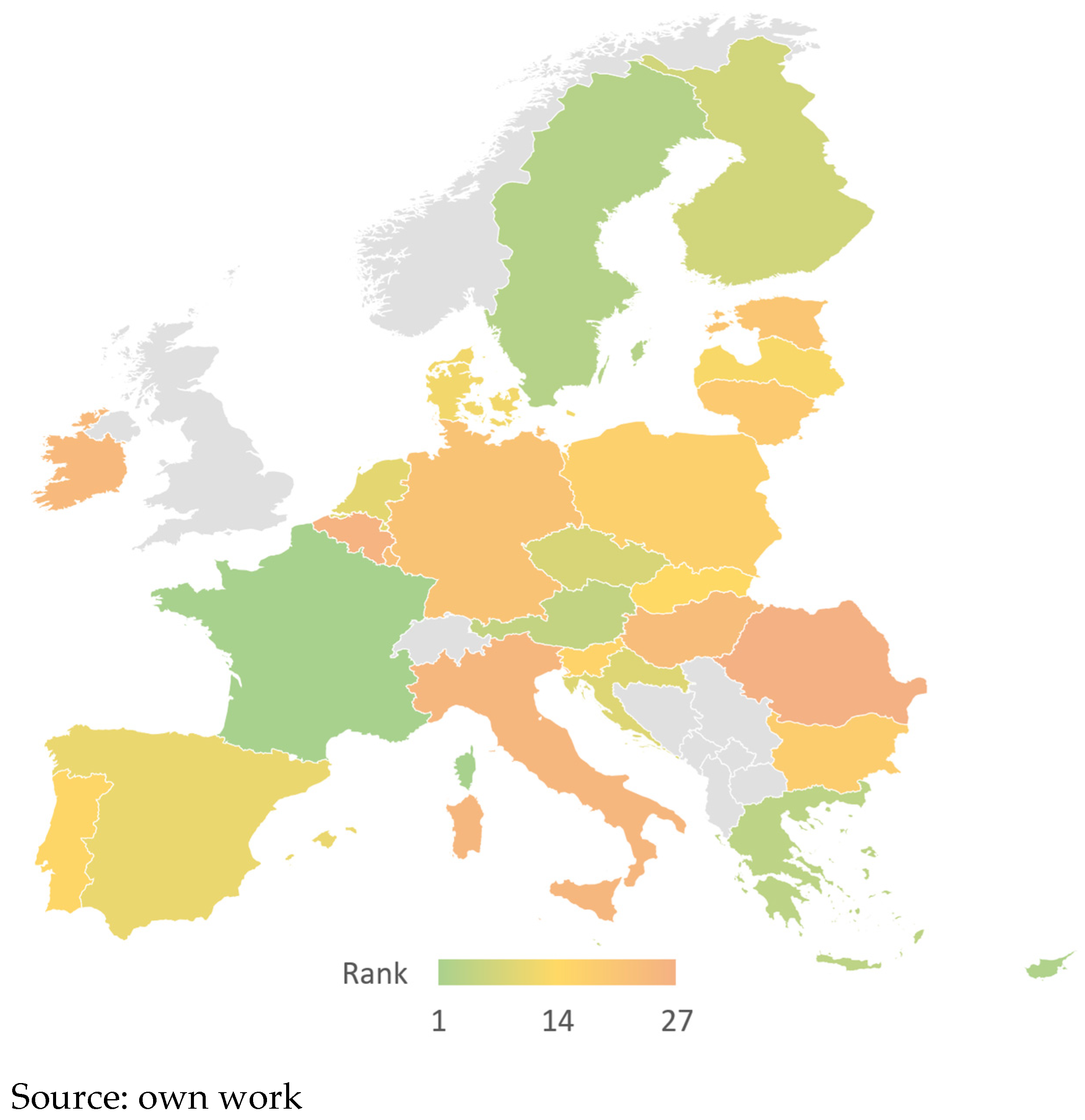
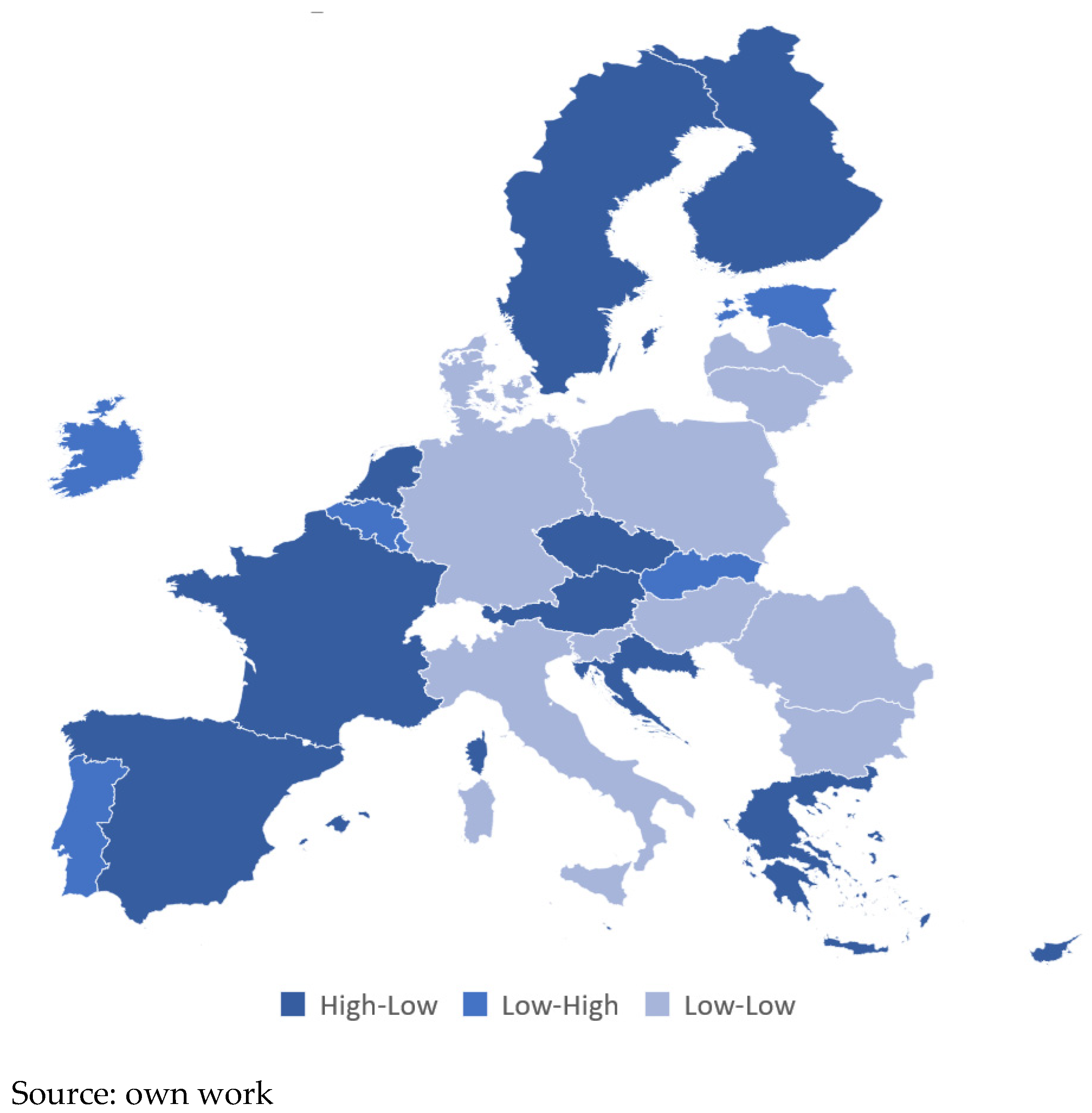
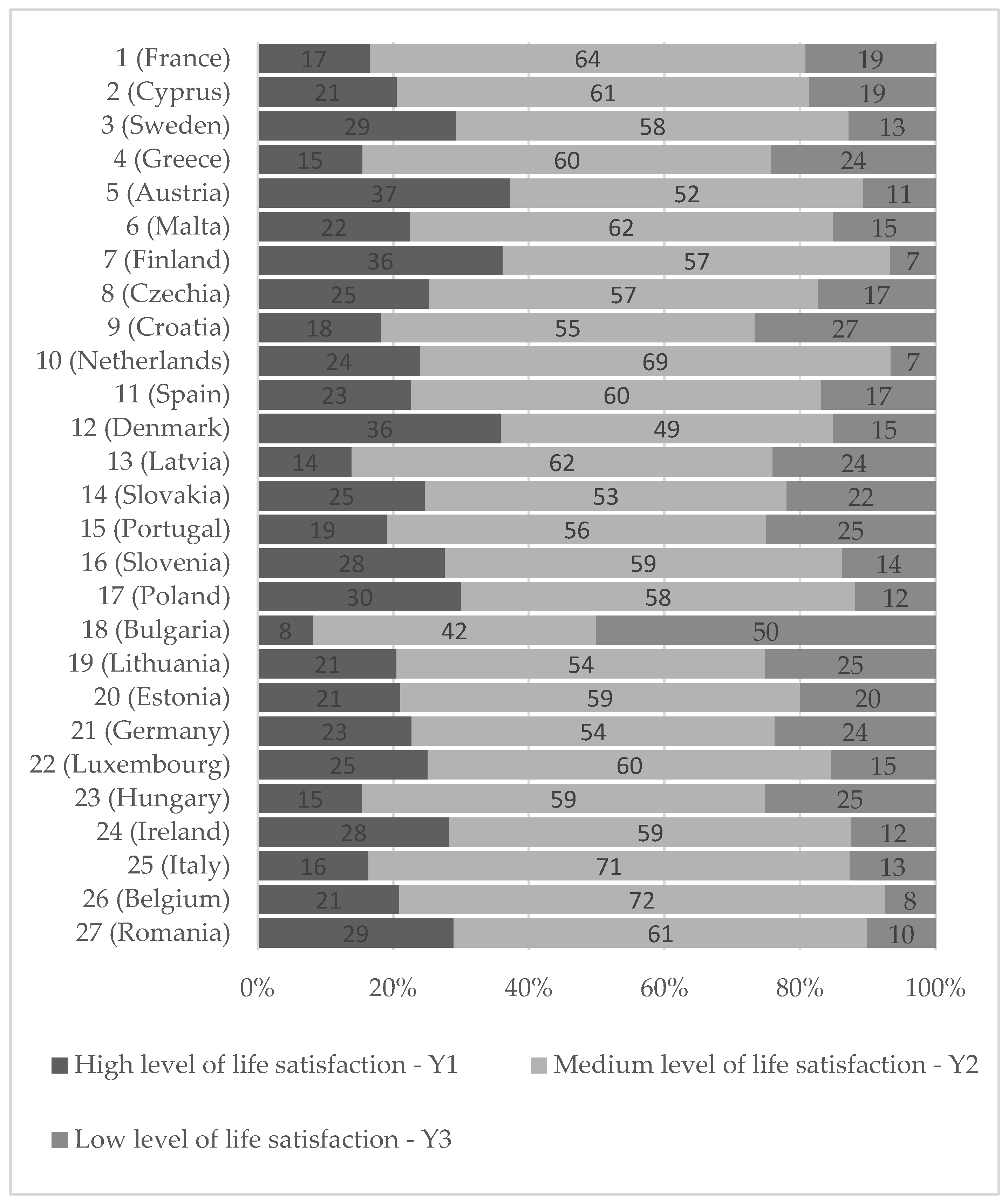
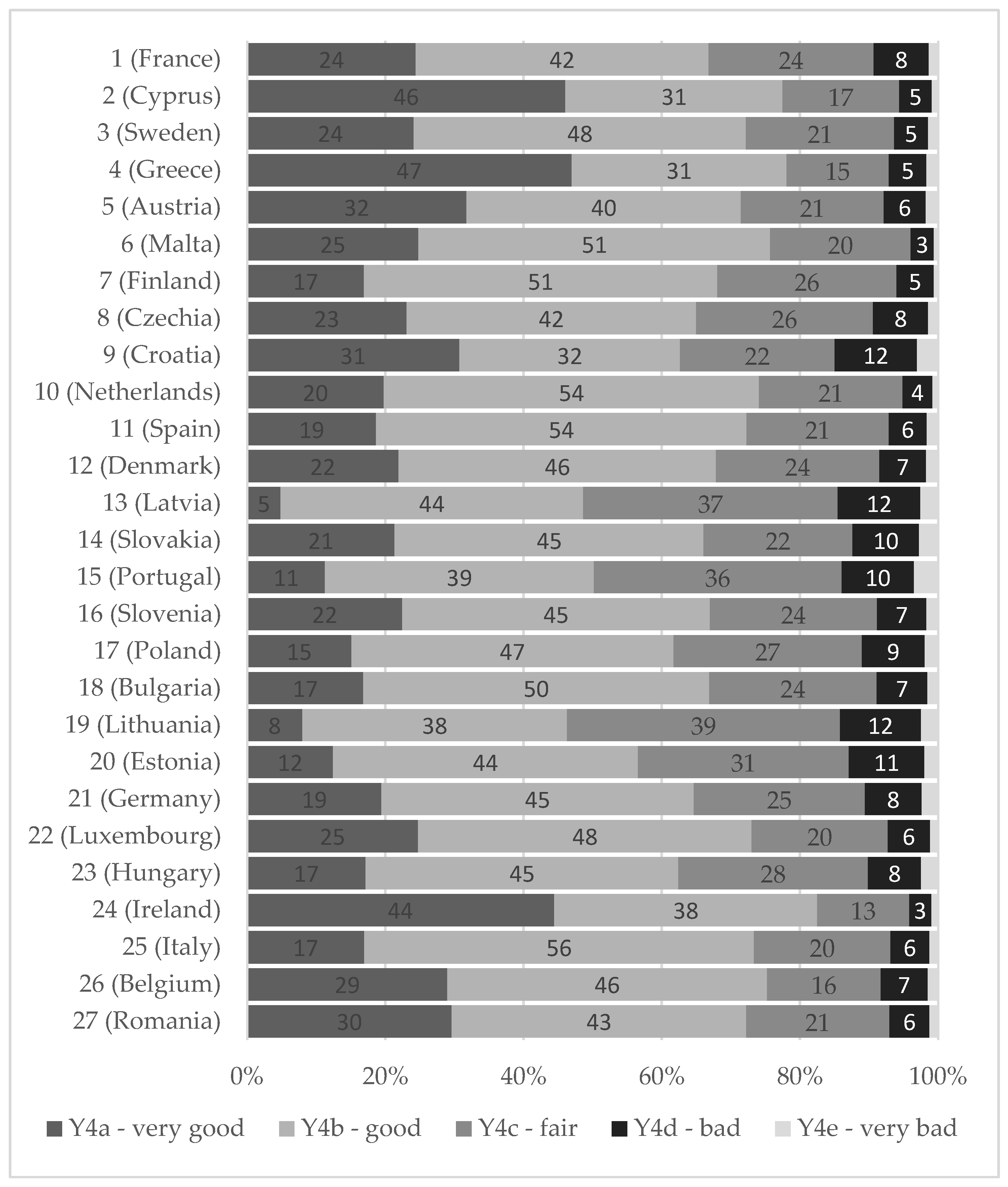

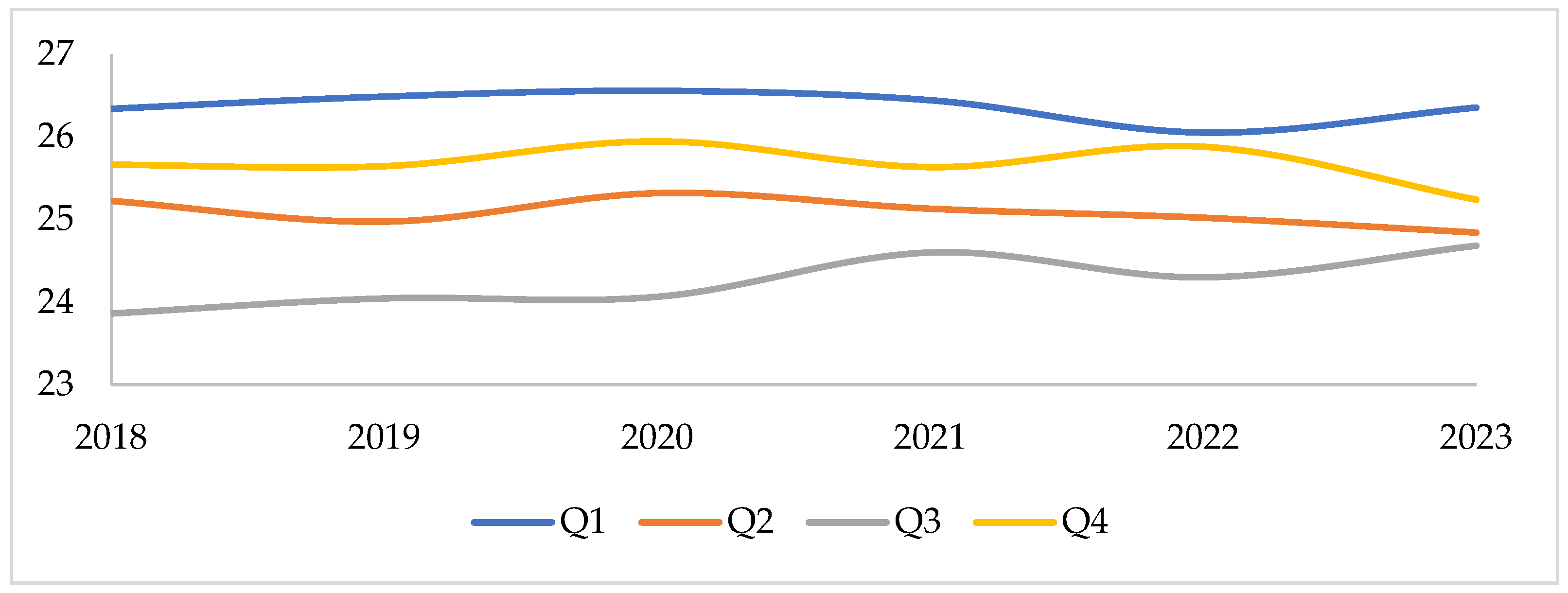
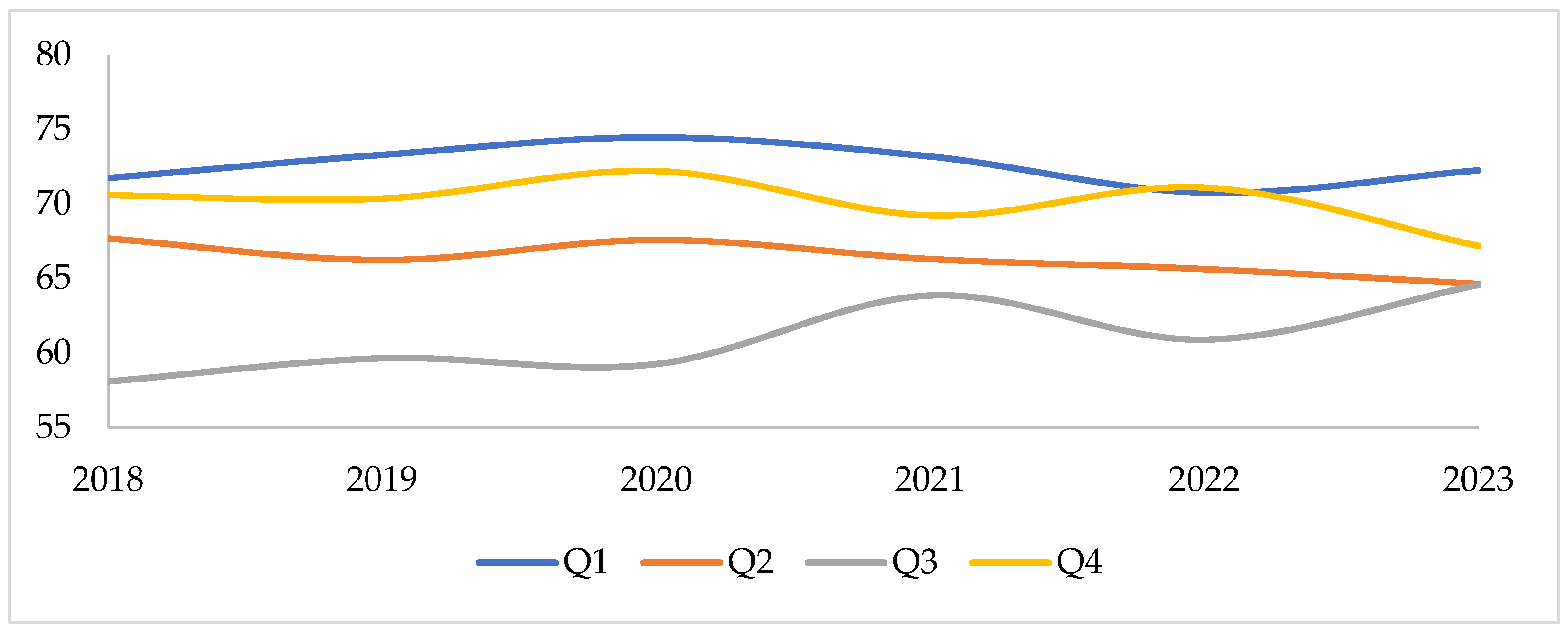
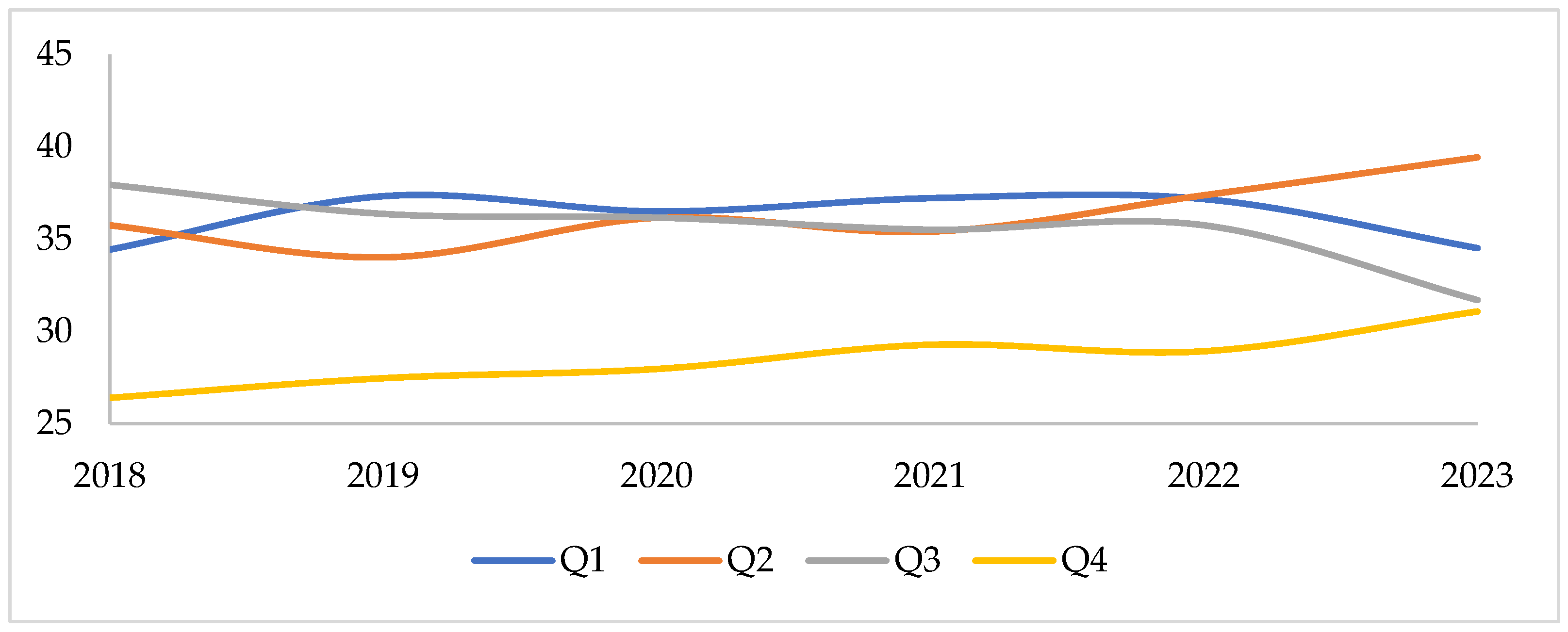
| Variable Name | Variable Description | Unit | DOI/Source |
|---|---|---|---|
| Variables Related to Environmental Safety | |||
| Indicators related to noise and the emission of harmful substances into the environment | |||
| X1 | Population living in households considering that they suffer from noise, by poverty status | % | https://doi.org/10.2908/SDG_11_20 (accessed on 10 June 2025) |
| X2 | Premature deaths due to exposure to fine particulate matter (PM2.5) | number of premature deaths per 100,000 people | https://doi.org/10.2908/SDG_11_52 (accessed on 10 June 2025) |
| X3 | Air emissions intensities by NACE Rev. 2 activity | grams per euro, current prices | https://doi.org/10.2908/ENV_AC_AEINT_R2 (accessed on 10 June 2025) |
| X4 | Pollution, grime or other environmental problems | % | https://doi.org/10.2908/ILC_MDDW02 (accessed on 10 June 2025) |
| Indicators related to waste management | |||
| X5 | Investments in climate change mitigation | € mln | https://doi.org/10.2908/ENV_AC_CCMINV (accessed on 10 June 2025) |
| X6 | Recycling rate of municipal waste | % | https://doi.org/10.2908/SDG_11_60 (accessed on 10 June 2025) |
| X7 | Circular material use rate | % | https://doi.org/10.2908/ENV_AC_CUR (accessed on 10 June 2025) |
| Indicators related to access to water and afforestation | |||
| X8 | Population connected to public water supply | % | https://doi.org/10.2908/ENV_WAT_POP (accessed on 10 June 2025) |
| X9 | Population connected to wastewater treatment plants | % | https://doi.org/10.2908/ENV_WW_CON (accessed on 10 June 2025) |
| X10 | Forest and other wooded land | % | https://doi.org/10.2908/SDG_15_10 (accessed on 10 June 2025) |
| X11 | Fresh water abstraction by source per capita—m3 per capita | m3 per capita | https://doi.org/10.2908/TEN00003 (accessed on 10 June 2025) |
| Variables related to subjective assessment of quality of life—life satisfaction | |||
| Y1 | Overall life satisfaction—High | % | https://doi.org/10.2908/ILC_PW05 (accessed on 10 June 2025) |
| Y2 | Overall life satisfaction—Medium | % | https://doi.org/10.2908/ILC_PW05 (accessed on 10 June 2025) |
| Y3 | Overall life satisfaction—Low | % | https://doi.org/10.2908/ILC_PW05 (accessed on 10 June 2025) |
| Variables related to subjective assessment of quality of life—health | |||
| Y4 | Self-perceived health | % | https://doi.org/10.2908/HLTH_SILC_18 (accessed on 10 June 2025) |
| Y5 | Share of people with good or very good perceived health | % | https://doi.org/10.2908/SDG_03_20 (accessed on 10 June 2025) |
| Y6 | People having a long-standing illness or health problem | % | https://doi.org/10.2908/HLTH_SILC_19 (accessed on 10 June 2025) |
| Economic variables | |||
| variable name | variable description | unit | source |
| Inflation | Annual CPI ratio | % | https://data.worldbank.org/indicator/FP.CPI.TOTL.ZG (accessed on 10 June 2025) |
| GDPgrowth | Annual GDP per capita growth | % | https://data.worldbank.org/indicator/NY.GDP.PCAP.KD.ZG (accessed on 10 June 2025) |
| AgeDependecy | Ratio of non-working to working-age people | % | https://data.worldbank.org/indicator/SP.POP.DPND (accessed on 10 June 2025) |
| Variable | 2018 | 2019 | 2020 | 2021 | 2022 | 2023 | Avg (2018–2023) |
|---|---|---|---|---|---|---|---|
| X1 | 0.057 | 0.059 | 0.068 | 0.067 | 0.067 | 0.070 | 0.065 |
| X2 | 0.108 | 0.112 | 0.127 | 0.121 | 0.111 | 0.110 | 0.115 |
| X3 | 0.099 | 0.092 | 0.090 | 0.091 | 0.089 | 0.075 | 0.089 |
| X4 | 0.068 | 0.072 | 0.070 | 0.070 | 0.070 | 0.081 | 0.072 |
| X5 | 0.247 | 0.267 | 0.254 | 0.262 | 0.273 | 0.275 | 0.263 |
| X6 | 0.064 | 0.060 | 0.061 | 0.061 | 0.061 | 0.058 | 0.061 |
| X7 | 0.116 | 0.112 | 0.112 | 0.109 | 0.105 | 0.110 | 0.111 |
| X8 | 0.036 | 0.036 | 0.035 | 0.035 | 0.035 | 0.034 | 0.035 |
| X9 | 0.019 | 0.018 | 0.017 | 0.017 | 0.016 | 0.016 | 0.017 |
| X10 | 0.065 | 0.065 | 0.064 | 0.064 | 0.064 | 0.063 | 0.064 |
| X11 | 0.120 | 0.107 | 0.102 | 0.104 | 0.109 | 0.108 | 0.108 |
| Variable | Mean | Std. Dev. | Skewness | Kurtosis | 5th Percentile | Median | 95th Percentile |
|---|---|---|---|---|---|---|---|
| X1 | 15.96 | 6.36 | 0.31 | −0.07 | 8.02 | 14.75 | 28.20 |
| X2 | 55.46 | 39.37 | 0.81 | 0.38 | 5.00 | 44.00 | 124.70 |
| X3 | 313.86 | 185.10 | 1.54 | 2.77 | 113.40 | 268.27 | 737.20 |
| X4 | 12.71 | 5.59 | 1.60 | 3.59 | 5.90 | 11.80 | 24.12 |
| X5 | 3138.60 | 5086.00 | 2.72 | 6.89 | 58.26 | 1289.00 | 17,706.00 |
| X6 | 40.28 | 14.92 | −0.26 | −0.59 | 12.30 | 40.95 | 62.60 |
| X7 | 9.71 | 6.57 | 0.98 | 0.35 | 1.82 | 8.50 | 21.49 |
| X8 | 89.24 | 19.01 | −3.84 | 15.29 | 71.13 | 93.00 | 100.00 |
| X9 | 92.04 | 9.64 | −1.83 | 4.05 | 78.90 | 95.96 | 100.00 |
| X11 | 348.28 | 230.80 | 1.21 | 1.35 | 79.60 | 348.28 | 890.60 |
| Y1–3 | 34.18 | 2.74 | −0.69 | 0.91 | 29.95 | 34.28 | 38.35 |
| Y4 | 25.31 | 1.43 | −0.11 | −0.02 | 22.58 | 25.31 | 27.86 |
| Y5 | 67.34 | 9.00 | −0.74 | 0.11 | 47.93 | 68.00 | 79.20 |
| Y6 | 34.08 | 8.08 | −0.22 | −0.27 | 19.53 | 35.50 | 47.29 |
| Inflation | 4.19 | 3.41 | 1.30 | 2.16 | 0.76 | 3.13 | 11.58 |
| GPDgrowth | 2.06 | 4.41 | −0.28 | 0.70 | −6.54 | 1.97 | 8.58 |
| AgeDependency | 54.41 | 4.80 | −0.77 | 0.31 | 43.89 | 55.32 | 61.63 |
| Panel A: Environmental Safety—ES_Score | Panel B: Environmental Safety—Ranks | ||||||||||||||
|---|---|---|---|---|---|---|---|---|---|---|---|---|---|---|---|
| Country/Year | 2018 | 2019 | 2020 | 2021 | 2022 | 2023 | Avg (2018–2023) | Country/Year | 2018 | 2019 | 2020 | 2021 | 2022 | 2023 | Avg (2018–2023) |
| ES_Score | Ranks | ||||||||||||||
| Austria | 0.48 | 0.45 | 0.46 | 0.42 | 0.41 | 0.41 | 0.44 | Austria | 4 | 5 | 7 | 7 | 6 | 7 | 5 |
| Belgium | 0.28 | 0.28 | 0.31 | 0.29 | 0.28 | 0.30 | 0.29 | Belgium | 26 | 26 | 26 | 25 | 26 | 22 | 26 |
| Bulgaria | 0.31 | 0.32 | 0.36 | 0.32 | 0.31 | 0.32 | 0.32 | Bulgaria | 22 | 18 | 17 | 17 | 18 | 16 | 18 |
| Croatia | 0.46 | 0.40 | 0.44 | 0.40 | 0.39 | 0.40 | 0.44 | Croatia | 5 | 10 | 10 | 11 | 9 | 8 | 9 |
| Cyprus | 0.63 | 0.66 | 0.70 | 0.66 | 0.69 | 0.69 | 0.67 | Cyprus | 2 | 2 | 2 | 2 | 2 | 2 | 2 |
| Czechia | 0.44 | 0.40 | 0.44 | 0.42 | 0.41 | 0.41 | 0.42 | Czechia | 9 | 9 | 9 | 8 | 5 | 6 | 8 |
| Denmark | 0.38 | 0.37 | 0.40 | 0.37 | 0.36 | 0.35 | 0.37 | Denmark | 12 | 12 | 12 | 12 | 12 | 12 | 12 |
| Estonia | 0.33 | 0.32 | 0.35 | 0.32 | 0.31 | 0.30 | 0.34 | Estonia | 16 | 20 | 19 | 20 | 21 | 23 | 20 |
| Finland | 0.46 | 0.44 | 0.46 | 0.43 | 0.39 | 0.38 | 0.43 | Finland | 7 | 6 | 6 | 6 | 11 | 10 | 7 |
| France | 0.73 | 0.77 | 0.72 | 0.73 | 0.74 | 0.74 | 0.74 | France | 1 | 1 | 1 | 1 | 1 | 1 | 1 |
| Germany | 0.32 | 0.32 | 0.33 | 0.31 | 0.31 | 0.32 | 0.32 | Germany | 19 | 19 | 24 | 23 | 20 | 18 | 21 |
| Greece | 0.48 | 0.45 | 0.47 | 0.45 | 0.40 | 0.42 | 0.45 | Greece | 3 | 4 | 4 | 4 | 7 | 4 | 4 |
| Hungary | 0.32 | 0.31 | 0.34 | 0.32 | 0.30 | 0.28 | 0.31 | Hungary | 18 | 22 | 22 | 19 | 23 | 26 | 23 |
| Ireland | 0.28 | 0.30 | 0.34 | 0.29 | 0.30 | 0.29 | 0.30 | Ireland | 25 | 24 | 23 | 24 | 24 | 24 | 24 |
| Italy | 0.30 | 0.30 | 0.32 | 0.28 | 0.29 | 0.30 | 0.30 | Italy | 23 | 25 | 25 | 26 | 25 | 20 | 25 |
| Latvia | 0.37 | 0.36 | 0.39 | 0.36 | 0.35 | 0.35 | 0.36 | Latvia | 13 | 13 | 13 | 13 | 13 | 13 | 13 |
| Lithuania | 0.32 | 0.32 | 0.35 | 0.31 | 0.31 | 0.30 | 0.32 | Lithuania | 17 | 17 | 20 | 21 | 19 | 21 | 19 |
| Luxembourg | 0.32 | 0.31 | 0.34 | 0.32 | 0.30 | 0.28 | 0.31 | Luxembourg | 20 | 23 | 21 | 18 | 22 | 25 | 22 |
| Malta | 0.44 | 0.43 | 0.46 | 0.43 | 0.42 | 0.41 | 0.43 | Malta | 8 | 7 | 5 | 5 | 4 | 5 | 6 |
| Netherlands | 0.42 | 0.41 | 0.45 | 0.41 | 0.40 | 0.39 | 0.42 | Netherlands | 10 | 8 | 8 | 9 | 8 | 9 | 10 |
| Poland | 0.30 | 0.31 | 0.37 | 0.32 | 0.33 | 0.32 | 0.33 | Poland | 24 | 21 | 16 | 16 | 14 | 17 | 17 |
| Portugal | 0.35 | 0.35 | 0.37 | 0.34 | 0.32 | 0.30 | 0.34 | Portugal | 15 | 15 | 15 | 15 | 17 | 19 | 15 |
| Romania | 0.26 | 0.27 | 0.29 | 0.27 | 0.28 | 0.27 | 0.27 | Romania | 27 | 27 | 27 | 27 | 27 | 27 | 27 |
| Slovakia | 0.37 | 0.36 | 0.38 | 0.35 | 0.33 | 0.32 | 0.35 | Slovakia | 14 | 14 | 14 | 14 | 15 | 15 | 14 |
| Slovenia | 0.31 | 0.33 | 0.36 | 0.31 | 0.32 | 0.33 | 0.33 | Slovenia | 21 | 16 | 18 | 22 | 16 | 14 | 16 |
| Spain | 0.41 | 0.40 | 0.43 | 0.40 | 0.39 | 0.37 | 0.40 | Spain | 11 | 11 | 11 | 10 | 10 | 11 | 11 |
| Sweden | 0.46 | 0.46 | 0.51 | 0.48 | 0.46 | 0.46 | 0.47 | Sweden | 6 | 3 | 3 | 3 | 3 | 3 | 3 |
| Country/Year | 2018 | 2019 | 2020 | 2021 | 2022 | 2023 | Avg (2018–2023) |
|---|---|---|---|---|---|---|---|
| Global | −0.0829 | −0.0733 | −0.0732 | −0.0691 | −0.0673 | −0.0650 | −0.0718 |
| Austria | −0.1281 | −0.1132 | −0.0985 | −0.0716 | −0.0742 | −0.0829 | −0.0947 |
| Belgium | −0.2056 | −0.1996 | −0.1824 | −0.1758 | −0.1717 | −0.1074 | −0.1738 |
| Bulgaria | 0.0598 | 0.0587 | 0.0607 | 0.0596 | 0.0562 | 0.0402 | 0.0559 |
| Croatia | −0.1308 | −0.0231 | −0.0533 | −0.0372 | −0.0280 | −0.0452 | −0.0529 |
| Cyprus | −0.2270 | −0.3061 | −0.3835 | −0.3281 | −0.4272 | −0.3726 | −0.3408 |
| Czechia | −0.0440 | −0.0148 | −0.0378 | −0.0510 | −0.0452 | −0.0452 | −0.0397 |
| Denmark | 0.0064 | 0.0104 | 0.0096 | 0.0075 | 0.0088 | 0.0109 | 0.0089 |
| Estonia | −0.1031 | −0.0776 | −0.0853 | −0.0767 | −0.0157 | −0.0059 | −0.0607 |
| Finland | −0.1559 | −0.1244 | −0.1118 | −0.1046 | −0.0337 | −0.0206 | −0.0918 |
| France | −0.9382 | −1.0753 | −0.9118 | −0.9415 | −0.9826 | −0.9474 | −0.9661 |
| Germany | 0.0048 | 0.0269 | 0.0231 | 0.0180 | 0.0191 | 0.0171 | 0.0182 |
| Greece | −0.0595 | −0.0312 | −0.0249 | −0.0356 | −0.0054 | −0.0072 | −0.0273 |
| Hungary | 0.0008 | 0.0381 | 0.0490 | 0.0509 | 0.0590 | 0.0558 | 0.0423 |
| Ireland | −0.0875 | −0.0656 | −0.0434 | −0.0740 | −0.0530 | −0.0578 | −0.0636 |
| Italy | −0.0200 | 0.0026 | 0.0040 | 0.0065 | 0.0089 | 0.0010 | 0.0005 |
| Latvia | 0.0199 | 0.0266 | 0.0229 | 0.0227 | 0.0275 | 0.0260 | 0.0243 |
| Lithuania | 0.0571 | 0.0607 | 0.0515 | 0.0577 | 0.0547 | 0.0589 | 0.0568 |
| Luxembourg | −0.0665 | −0.0828 | −0.0576 | −0.0649 | −0.0845 | −0.1292 | −0.0809 |
| Malta | −0.0187 | −0.0201 | −0.0287 | −0.0285 | −0.0256 | −0.0131 | −0.0224 |
| Netherlands | −0.0332 | −0.0224 | −0.0520 | −0.0245 | −0.0211 | −0.0106 | −0.0273 |
| Poland | 0.0564 | 0.0672 | 0.0482 | 0.0605 | 0.0454 | 0.0497 | 0.0546 |
| Portugal | −0.0172 | −0.0144 | −0.0158 | −0.0172 | −0.0244 | −0.0236 | −0.0187 |
| Romania | 0.0548 | 0.0598 | 0.0488 | 0.0587 | 0.0592 | 0.0393 | 0.0534 |
| Slovakia | −0.0294 | −0.0121 | −0.0074 | 0.0008 | 0.0030 | −0.0022 | −0.0079 |
| Slovenia | −0.0783 | 0.0122 | 0.0100 | 0.0182 | 0.0200 | 0.0071 | −0.0018 |
| Spain | −0.0029 | −0.0002 | −0.0054 | −0.0034 | −0.0033 | 0.0002 | −0.0025 |
| Sweden | −0.0692 | −0.0862 | −0.1323 | −0.1236 | −0.1164 | −0.1264 | −0.1090 |
| Quartile | Level of Environmental Safety | Countries |
|---|---|---|
| 1st (ranks 1–7) | High | France, Cyprus, Sweden, Greece, Austria, Malta, Finland |
| 2nd (ranks 8–14) | Medium | Czechia, Croatia, Netherlands, Spain, Denmark, Latvia, Slovakia |
| 3rd (ranks 15–21) | Low | Portugal, Slovenia, Poland, Bulgaria, Lithuania, Estonia, Germany |
| 4th (ranks 22–27) | Very low | Luxembourg, Hungary, Ireland, Italy, Belgium, Romania |
| Variable | Y4 | Y5 | Y6 | ES_Score | X1 | X2 | X3 | X4 | X5 | X6 | X7 | X8 | X9 | X11 | Inflation | GPDgrowth | AgeDependency |
|---|---|---|---|---|---|---|---|---|---|---|---|---|---|---|---|---|---|
| Y1–3 | 0.36 | 0.40 | 0.12 | 0.03 | 0.19 | −0.57 | −0.54 | −0.17 | 0.05 | 0.27 | 0.20 | 0.08 | 0.25 | −0.28 | −0.15 | −0.14 | 0.00 |
| Y4 | 0.96 | −0.48 | 0.30 | 0.19 | −0.06 | −0.30 | 0.00 | −0.03 | −0.19 | 0.07 | 0.37 | 0.21 | 0.15 | −0.25 | 0.03 | 0.09 | |
| Y5 | −0.53 | 0.21 | 0.21 | −0.09 | −0.34 | 0.01 | 0.02 | −0.08 | 0.21 | 0.41 | 0.28 | 0.16 | −0.24 | −0.01 | 0.09 | ||
| Y6 | 0.28 | −0.27 | 0.16 | 0.16 | −0.06 | −0.13 | 0.19 | −0.07 | −0.09 | −0.35 | 0.05 | 0.22 | 0.05 | −0.19 | |||
| ES_Score | 0.26 | −0.45 | −0.45 | 0.04 | 0.91 | 0.48 | 0.48 | 0.26 | 0.47 | 0.04 | −0.28 | −0.24 | 0.34 | ||||
| X1 | −0.39 | −0.47 | 0.62 | 0.25 | 0.03 | 0.30 | 0.23 | 0.22 | −0.10 | −0.23 | −0.15 | 0.14 | |||||
| X2 | 0.73 | 0.03 | −0.21 | −0.34 | −0.28 | 0.00 | −0.42 | 0.20 | 0.23 | 0.25 | −0.03 | ||||||
| X3 | −0.04 | −0.32 | −0.39 | −0.34 | −0.11 | −0.38 | 0.35 | 0.13 | 0.18 | −0.04 | |||||||
| X4 | 0.12 | −0.17 | 0.23 | −0.02 | 0.04 | −0.02 | −0.10 | 0.01 | 0.23 | ||||||||
| X5 | 0.37 | 0.34 | 0.21 | 0.29 | −0.05 | −0.13 | −0.11 | 0.49 | |||||||||
| X6 | 0.41 | 0.05 | 0.45 | −0.20 | −0.08 | −0.16 | −0.15 | ||||||||||
| X7 | 0.29 | 0.40 | 0.04 | −0.08 | −0.15 | −0.07 | |||||||||||
| X8 | 0.37 | 0.18 | −0.09 | −0.06 | −0.06 | ||||||||||||
| X9 | −0.05 | −0.33 | −0.12 | −0.11 | |||||||||||||
| X11 | 0.09 | 0.02 | 0.07 | ||||||||||||||
| Inflation | 0.09 | 0.07 | |||||||||||||||
| GPDgrowth | −0.03 |
| Model | (1) | (2) | (3) | (4) | (5) | (6) | (7) | (8) |
|---|---|---|---|---|---|---|---|---|
| Dep. Variable | Y1–3 | Y1–3 | Y4 | Y4 | Y5 | Y5 | Y6 | Y6 |
| const | 65.826 * (1.75) | 54.478 (1.49) | 22.334 *** (3.64) | 21.184 *** (3.76) | 51.919 (1.54) | 37.451 (1.18) | 19.392 (0.71) | 57.690 * (1.85) |
| X1 | −0.047 (1.18) | −0.044 (1.11) | −0.014 (1.08) | −0.003 (0.20) | −0.056 (0.57) | 0.029 (0.26) | 0.068 (0.51) | 0.065 (0.48) |
| X2 | 0.008 (0.98) | 0.011 (1.03) | 0.001 (0.64) | 0.002 (0.76) | 0.009 (0.58) | 0.019 (0.99) | −0.005 (0.27) | −0.004 (0.16) |
| X3 | −0.008 *** (3.54) | −0.008 *** (3.55) | −0.001 (0.77) | −0.001 (0.96) | −0.002 (0.48) | −0.006 (0.87) | −0.001 (0.25) | 0.002 (0.50) |
| X4 | 0.125 ** (2.13) | 0.116 * (1.83) | 0.007 (0.45) | 0.004 (0.17) | 0.001 (0.01) | −0.046 (0.33) | 0.173 (1.55) | 0.230 * (1.80) |
| X5 | −0.0002 *** (3.59) | −0.0002 ** (2.35) | −0.000 (1.63) | −0.000 (0.87) | −0.0003 * (1.77) | −0.000 (0.89) | −0.000 (0.25) | −0.000 (0.82) |
| X6 | −0.011 (0.505) | −0.002 (0.08) | 0.014 (1.48) | 0.016 * (1.75) | 0.111 * (2.04) | 0.126 ** (2.47) | −0.004 (0.07) | −0.034 (0.70) |
| X7 | −0.093 * (1.95) | −0.059 (1.13) | −0.033 (1.00) | −0.029 (1.01) | −0.259 (1.18) | −0.2033 (1.04) | 0.187 (1.19) | 0.050 (0.35) |
| X8 | 0.077 (0.19) | 0.134 (0.34) | −0.025 (0.29) | 0.012 (0.15) | −0.305 (0.60) | 0.011 (0.02) | −0.045 (0.09) | −0.141 (0.27) |
| X9 | −0.323 (1.67) | −0.301 (1.60) | 0.056 (0.784) | 0.030 (0.448) | 0.557 (1.32) | 0.354 (0.85) | −0.008 (0.02) | −0.034 (0.07) |
| X11 | 0.005 ** (2.07) | 0.004 * (2.04) | −0.001 (1.61) | −0.001 (1.19) | −0.009 ** (2.11) | −0.007 (1.65) | 0.007 * (1.750) | 0.008 * (1.93) |
| Inflation | 0.032 (1.07) | 0.119 *** (3.62) | −0.007 (0.45) | 0.025 (1.22) | 0.033 (0.39) | 0.320 *** (3.97) | −0.052 (0.73) | −0.219 ** (2.58) |
| GDPgrowth | −0.021 (1.20) | 0.019 (0.46) | 0.001 (0.11) | 0.010 (0.84) | −0.020 (0.64) | 0.019 (0.334) | −0.003 (0.16) | −0.050 (1.13) |
| AgeDependency | −0.135 (0.85) | −0.076 (0.36) | 0.012 (0.28) | 0.009 (0.14) | 0.099 (0.39) | −0.069 (0.20) | 0.240 (0.93) | −0.256 (0.83) |
| Country effects | Yes | Yes | Yes | Yes | Yes | Yes | Yes | Yes |
| Year effects | No | Yes | No | Yes | No | Yes | No | Yes |
| No. of obs. | 162 | 162 | 162 | 162 | 162 | 162 | 162 | 162 |
| Within R2 | 0.248 | 0.300 | 0.116 | 0.204 | 0.152 | 0.288 | 0.112 | 0.220 |
| Model | (1) | (3) | (5) | (8) |
|---|---|---|---|---|
| Dep. Variable | Y1–3 | Y4 | Y5 | Y6 |
| const | 29.817 ** (2.22) | 20.027 *** (3.21) | 17.553 (0.45) | 12.601 (0.29) |
| X1 | 0.072 (0.44) | 0.026 (0.34) | 0.153 (0.32) | 0.072 (0.14) |
| X2 | −0.030 (1.21) | 0.014 (1.23) | 0.110 (1.53) | −0.152 * (1.92) |
| X3 | −0.002 (0.26) | −0.006 * (2.03) | −0.041 ** (2.26) | 0.021 (1.03) |
| X4 | −0.179 (1.14) | −0.064 (0.88) | −0.427 (0.94) | −0.263 (0.53) |
| X5 | −0.000 (1.06) | −0.000 (0.139) | −0.001 (1.69) | 0.000 (0.71) |
| X6 | 0.028 (0.51) | −0.014 (0.54) | −0.062 (0.39) | −0.090 (0.52) |
| X7 | 0.091 (0.87) | 0.038 (0.78) | 0.400 (1.32) | −0.292 (0.88) |
| X8 | 0.017 (0.50) | 0.019 (1.22) | 0.118 (1.20) | −0.058 (0.54) |
| X9 | −0.029 (0.32) | 0.003 (0.06) | 0.091 (0.34) | 0.313 (1.07) |
| X11 | −0.002 (0.90) | 0.002 (1.43) | 0.010 (1.43) | −0.004 (0.56) |
| Inflation | −0.177 (0.36) | −0.290 (1.28) | −1.347 (0.95) | 1.740 (1.12) |
| GDPgrowth | 0.317 (0.52) | 0.388 (1.37) | 1.970 (1.11) | −1.21 (0.62) |
| AgeDependency | 0.150 (1.02) | 0.094 (1.37) | 0.726 (1.69) | 0.076 (0.16) |
| No. of obs. | 162 | 162 | 162 | 162 |
| Adj. R2 | 0.554 | 0.672 | 0.675 | 0.513 |
Disclaimer/Publisher’s Note: The statements, opinions and data contained in all publications are solely those of the individual author(s) and contributor(s) and not of MDPI and/or the editor(s). MDPI and/or the editor(s) disclaim responsibility for any injury to people or property resulting from any ideas, methods, instructions or products referred to in the content. |
© 2025 by the authors. Licensee MDPI, Basel, Switzerland. This article is an open access article distributed under the terms and conditions of the Creative Commons Attribution (CC BY) license (https://creativecommons.org/licenses/by/4.0/).
Share and Cite
Murawska, A.; Sieg, P.; Stereńczak, S. Environmental Safety and Self-Perceived Quality of Life and Health: The Example of the European Union. Sustainability 2025, 17, 8412. https://doi.org/10.3390/su17188412
Murawska A, Sieg P, Stereńczak S. Environmental Safety and Self-Perceived Quality of Life and Health: The Example of the European Union. Sustainability. 2025; 17(18):8412. https://doi.org/10.3390/su17188412
Chicago/Turabian StyleMurawska, Anna, Patrycja Sieg, and Szymon Stereńczak. 2025. "Environmental Safety and Self-Perceived Quality of Life and Health: The Example of the European Union" Sustainability 17, no. 18: 8412. https://doi.org/10.3390/su17188412
APA StyleMurawska, A., Sieg, P., & Stereńczak, S. (2025). Environmental Safety and Self-Perceived Quality of Life and Health: The Example of the European Union. Sustainability, 17(18), 8412. https://doi.org/10.3390/su17188412







